 W
WLyra is a small constellation. It is one of 48 listed by the 2nd century astronomer Ptolemy, and is one of the 88 constellations recognized by the International Astronomical Union. Lyra was often represented on star maps as a vulture or an eagle carrying a lyre, and hence is sometimes referred to as Vultur Cadens or Aquila Cadens, respectively. Beginning at the north, Lyra is bordered by Draco, Hercules, Vulpecula, and Cygnus. Lyra is nearly overhead in temperate northern latitudes shortly after midnight at the start of summer. From the equator to about the 40th parallel south it is visible low in the northern sky during the same months.
 W
W17 Lyrae is a multiple star system in the constellation Lyra, approximately 136 light years away from Earth.
 W
WBeta Lyrae officially named Sheliak, the traditional name of the system, is a multiple star system in the constellation of Lyra. Based on parallax measurements obtained during the Hipparcos mission, it is approximately 960 light-years distant from the Sun.
 W
WDelta Lyrae cluster is a sparse open cluster of stars located about 1,220 light years away in the northern constellation of Lyra. Centered on the member star Delta2 Lyrae for which it is named.
 W
WDelta2 Lyrae is a 4th magnitude star in the constellation Lyra, approximately 900 light years away from Earth. It is one of the M4II spectral standard stars, meaning it is a bright giant star with a surface temperature around 3,600 kelvins. It puts out more energy than 10,000 suns, although more than 90% of it at longer than visual wavelengths. Direct angular measurements, combined with the Hipparcos parallax, give a radius of 1.1 - 1.3 astronomical units, comparable to the size calculated from other observed data.
 W
WEpsilon Lyrae, also known as the Double Double, is a multiple star system of at least five stars approximately 162 light-years away in the constellation of Lyra.
 W
WGamma Lyrae, formally named Sulafat, is the second-brightest star in the northern constellation of Lyra. With an apparent visual magnitude of 3.3, it is readily visible to the naked eye. Parallax measurements yield an estimated distance of 620 light-years from the Sun. At that distance, the visual magnitude of the star is diminished by an extinction factor of 0.12±0.03 due to interstellar dust.
 W
WGliese 758 is a star in the northern constellation of Lyra. At about magnitude 6 it is a challenge to view with the naked eye even in good seeing conditions, but can be easily seen through a small telescope or binoculars. Parallax measurements from the Hipparcos mission give it an estimated distance of around 51.4 light-years from Earth.
 W
WGliese 758 B is a brown dwarf or Super-Jupiter orbiting the G-type main sequence star Gliese 758, located approximately 50 light years away, in the constellation Lyra.
 W
WHAT-P-5b is a transiting extrasolar planet located approximately 1000 light-years away in the constellation of Lyra, orbiting the star HAT-P-5. It is a hot Jupiter with a mass 6% greater than Jupiter and a radius 26% greater than Jupiter, corresponding to a density of 0.66 g/cm3, which is less than water. This planet was found by Bakos et al. on October 9, 2007.
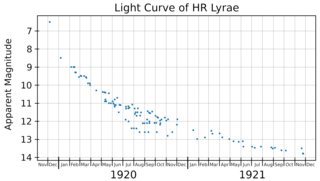 W
WHR Lyrae or Nova Lyrae 1919 was a nova which occurred in the constellation Lyra in 1919. Its discovery was announced by Johanna C. Mackie on 6 December 1919. She discovered it while examining photographic plates taken at the Harvard College Observatory. The bulletin announcing the discovery states "Between December 4 and 6 it rose rapidly from the sixteenth magnitude or fainter, to a maximum of about 6.5". It was the first nova ever reported in Lyra, and Mackie was awarded the AAVSO gold medal for her discovery. Its peak magnitude of 6.5 implies that it might have been visible to the naked eye, under ideal conditions.
 W
Wκ Lyrae, Latinized as Kappa Lyrae, is a solitary star in the northern constellation of Lyra, near the constellation border with Hercules. It is visible to the naked eye as a faint, orange-hued point of light with an apparent visual magnitude of 4.33. This object is located approximately 238 light years from the Sun based on parallax, but is moving closer with a radial velocity of −24 km/s.
 W
WKepler-7 is a star located in the constellation Lyra in the field of view of the Kepler Mission, a NASA operation in search of Earth-like planets. It is home to the fourth of the first five planets that Kepler discovered; this planet, a Jupiter-size gas giant named Kepler-7b, is as light as styrofoam. The star itself is more massive than the Sun, and is nearly twice the Sun's radius. It is also slightly metal-rich, a major factor in the formation of planetary systems. Kepler-7's planet was presented on January 4, 2010 at a meeting of the American Astronomical Society.
 W
WKepler-7b is one of the first five exoplanets to be confirmed by NASA's Kepler spacecraft, and was confirmed in the first 33.5 days of Kepler's science operations. It orbits a star slightly hotter and significantly larger than the Sun that is expected to soon reach the end of the main sequence. Kepler-7b is a hot Jupiter that is about half the mass of Jupiter, but is nearly 1.5 times its size; at the time of its discovery, Kepler-7b was the second most diffuse planet known, surpassed only by WASP-17b. It orbits its host star every five days at a distance of approximately 0.06 AU. Kepler-7b was announced at a meeting of the American Astronomical Society on January 4, 2010. It is the first extrasolar planet to have a crude map of cloud coverage.
 W
WKepler-8b is the fifth of the first five exoplanets discovered by NASA's Kepler spacecraft, which aims to discover planets in a region of the sky between the constellations Lyra and Cygnus that transit their host stars. The planet is the hottest of the five. Kepler-8b was the only planet discovered in Kepler-8's orbit, and is larger than Jupiter. It orbits its host star every 3.5 days. The planet also demonstrates the Rossiter–McLaughlin effect, where the planet's orbit affects the redshifting of the spectrum of the host star. Kepler-8b was announced to the public on January 4, 2010 at a conference in Washington, D.C. after radial velocity measurements conducted at the W.M. Keck Observatory confirmed its detection by Kepler.
 W
WKepler-9 is a sunlike star in the constellation Lyra. Its planetary system, discovered by the Kepler Mission in 2010 was the first detected with the transit method found to contain multiple planets.
 W
WKepler-9b is one of the first planets discovered outside the solar system (exoplanets) by NASA's Kepler Mission. It revolves around the star Kepler-9 within the constellation Lyra. Kepler-9b is the largest of three planets detected in the Kepler system by transit method; its mass is roughly half that of the planet Saturn, and it is the largest planet in its system. Kepler-9b and Kepler-9c display a phenomenon called orbital resonance, in which gravitational pull from each planet alters and stabilizes the orbit of the other. The planet's discovery was announced on August 26, 2010.
 W
WKepler-9c is one of the first seven extrasolar planets, exoplanets, discovered by NASA's Kepler Mission, and one of at least two planets orbiting the star Kepler-9. Kepler-9c and Kepler-9b were the first exoplanets confirmed to be transiting their star. The planet's discovery was announced by the Kepler Mission team on August 26, 2010 after its initial discovery by Kepler. At the time, it was one of 700 planetary candidates noted by Kepler.
Kepler-9d is a planet in orbit around the sun-like star Kepler-9. Initially discovered by Kepler spacecraft, a terrestrial planet-searching satellite built and operated by NASA, Kepler-9d is most likely a Super-Earth, with an estimated radius approximately 60% larger than that of Earth's, although its exact mass cannot be determined. Kepler-9d orbits Kepler-9 every 1.56 days at a distance of .0273 AU from its star, an extremely close distance. Although Kepler-9d is the closest planet to its star in its system, it is named Kepler-9d instead of Kepler-9b because two gas giants, Kepler-9b and Kepler-9c, were confirmed first. The original studies into the system first suggested that Kepler-9d might be a planet, but a follow-up investigation made by the Kepler team later confirmed that it was; the confirmation of Kepler-9d as a planet was made public with the team's paper, which was published in the Astrophysical Journal on January 1, 2011. The team used telescopes at the W.M. Keck Observatory in Hawaii to follow up on the Kepler space telescope's initial discovery.
 W
WKepler-37, also known as UGA-1785, is a G-type main-sequence star located in the constellation Lyra 209 light years from Earth. It is host to exoplanets Kepler-37b, Kepler-37c, Kepler-37d and Kepler-37e, all of which orbit very close to it. Kepler-37 has a mass about 80.3 percent of the Sun's and a radius about 77 percent as large. It has a temperature similar to that of the Sun, but a bit cooler at 5,417 K. It has about half the metallicity of our Sun. With an age of roughly 6 billion years, it is slightly older than the Sun, but is still a main-sequence star. Until January 2015, Kepler-37 was the smallest star to be measured via asteroseismology.
 W
WKepler-37b is an extrasolar planet (exoplanet) orbiting Kepler-37 in the constellation Lyra. As of February 2013 it is the smallest planet discovered around a main-sequence star, with a radius slightly greater than that of the Moon. The measurements do not constrain its mass, but masses above a few times that of the Moon give unphysically high densities.
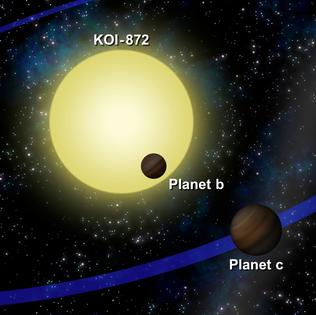 W
WKepler-46, previously designated KOI-872, is a star located in the constellation Lyra. Observed since 2009 by the Kepler space observatory, it has since been found to possess a planetary system consisting of at least two planets and while it has a similar mass to the Sun (90%) it is significantly older at ten billion years.
 W
WKepler-62e is a super-Earth exoplanet discovered orbiting within the habitable zone of Kepler-62, the second outermost of five such planets discovered by NASA's Kepler spacecraft. Kepler-62e is located about 1,200 light-years (370 pc) from Earth in the constellation of Lyra. The exoplanet was found using the transit method, in which the dimming effect that a planet causes as it crosses in front of its star is measured. Kepler-62e may be a terrestrial or ocean-covered planet; it lies in the inner part of its host star's habitable zone.
 W
WKepler-62f, which is also known by its Kepler Object of Interest designation KOI-701.04, is a super-Earth exoplanet. It is orbiting within the habitable zone of the star Kepler-62, the outermost of five such planets discovered around the star by NASA's Kepler spacecraft. It is located about 1200 light-years from Earth in the constellation of Lyra.
 W
WKepler-438b is a confirmed near-Earth-sized exoplanet. It is likely rocky. It orbits on the inner edge of the habitable zone of a red dwarf, Kepler-438, about 472.9 light-years from Earth in the constellation Lyra. It receives 1.4 times our solar flux. The planet was discovered by NASA's Kepler spacecraft using the transit method, in which the dimming effect that a planet causes as it crosses in front of its star is measured. NASA announced the confirmation of the exoplanet on 6 January 2015.
 W
WKepler-440b is a confirmed super-Earth exoplanet orbiting within the habitable zone of Kepler-440, about 850 light-years (261 pc) from Earth. The planet was discovered by NASA's Kepler spacecraft using the transit method, in which the dimming effect that a planet causes as it crosses in front of its star is measured. NASA announced the confirmation of the exoplanet on 6 January 2015.
 W
WKepler-442b is a confirmed near-Earth-sized exoplanet, likely rocky, orbiting within the habitable zone of the K-type main-sequence star Kepler-442, about 1,206 light-years, from Earth in the constellation Lyra. The planet was discovered by NASA's Kepler spacecraft using the transit method, in which the dimming effect that a planet causes as it crosses in front of its star is measured. NASA announced the confirmation of the exoplanet on 6 January 2015.
 W
WKSw 71 is a rapidly-spinning star in the constellation of Lyra. It is thought to have formed after two stars in a close binary system merged; its rotation has deformed it into an oblate spheroid shape. KSw 71 was discovered, alongside other pumpkin-shaped stars by NASA's Kepler and Swift missions and produces X-rays at more than 100 times the peak levels ever seen from the Sun.
 W
WLSR J1835+3259 is a nearby ultracool dwarf of spectral class M8.5, located in constellation Lyra, the discovery of which was published in 2003. Previously it was concluded that this star is a young brown dwarf, but no lithium absorption lines are detected for this object, which is a strong indicator for young brown dwarfs that need 10-100 million years deplete lithium.
 W
WMessier 56 is a globular cluster in the constellation Lyra. It was discovered by Charles Messier on January 19, 1779. The cluster is located almost midway along an imaginary line between Albireo and Sulafat. It is a challenge to find with large (50–80 mm) binoculars, appearing as a slightly fuzzy star. The cluster can be resolved using a telescope with an aperture of 8 in (20 cm) or larger.
 W
WNGC 6745 is an irregular galaxy about 206 million light-years away in the constellation Lyra. It is actually a trio of galaxies in the process of colliding.
 W
WNGC 6791 is an open star cluster in the Lyra constellation. It was discovered by Friedrich August Theodor Winnecke in 1853. At roughly 8 billion years old, and with an Iron to Hydrogen abundance ratio that is more than twice that of the Sun, it is one of the oldest and most metal-rich clusters in the Milky Way. This is contrary to the typical rule-of-thumb where older means more metal-poor. Compounded with the fact that it has an unusually high population of stars, NGC 6791 is among the most studied clusters in the sky.
 W
WR Lyrae is a 4th magnitude semiregular variable star in the constellation Lyra, approximately 350 light years away from Earth. It is a red giant star of the spectral type M5III, meaning it has a surface temperature of under 3,500 kelvins. It is much larger and brighter, yet cooler, than the Sun. In the near-infrared J band, it is brighter than the nearby Vega.
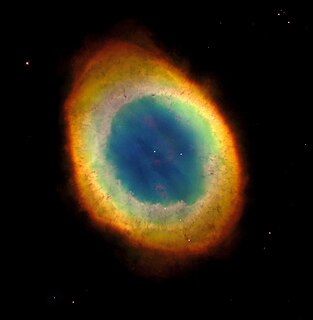 W
WThe Ring Nebula is a planetary nebula in the northern constellation of Lyra. Such objects are formed when a shell of ionized gas is expelled into the surrounding interstellar medium by a star in the last stages of its evolution before becoming a white dwarf.
 W
WRR Lyrae is a variable star in the Lyra constellation, figuring in its west near to Cygnus. As the brightest star in its class, it became the eponym for the RR Lyrae variable class of stars and it has been extensively studied by astronomers. RR Lyrae variables serve as important standard candles that are used to measure astronomical distances. The period of pulsation of an RR Lyrae variable depends on its mass, luminosity and temperature, while the difference between the measured luminosity and the actual luminosity allows its distance to be determined via the inverse-square law. Hence, understanding the period-luminosity relation for a local set of such stars allows the distance of more distant stars of this type to be determined.
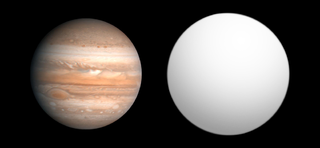 W
WTrES-1b is an extrasolar planet approximately 523 light-years away in the constellation of Lyra. The planet's mass and radius indicate that it is a Jovian planet with a similar bulk composition to Jupiter. Unlike Jupiter, but similar to many other planets detected around other stars, TrES-1 is located very close to its star, and belongs to the class of planets known as hot Jupiters. The planet was discovered orbiting around GSC 02652-01324.
 W
WV473 Lyrae is a variable star in the constellation Lyra. It is an unusual Classical Cepheid variable with a visual range of 5.99 to 6.35.
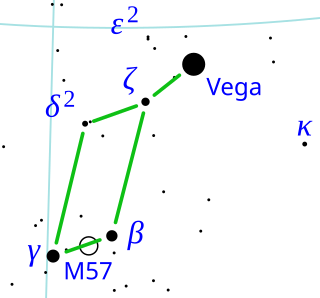 W
WVega is the brightest star in the northern constellation of Lyra. It has the Bayer designation α Lyrae, which is Latinised to Alpha Lyrae and abbreviated Alpha Lyr or α Lyr. This star is relatively close at only 25 light-years from the Sun, and, together with Arcturus and Sirius, one of the most luminous stars in the Sun's neighborhood. It is the fifth-brightest star in the night sky, and the second-brightest star in the northern celestial hemisphere, after Arcturus.
 W
WWASP-3b is an extrasolar planet orbiting the star WASP-3 located approximately 800 light-years away in the constellation Lyra. It was discovered via the transit method by SuperWASP, and follow up radial velocity observations confirmed that WASP-3b is a planet. The planet's mass and radius indicate that it is a gas giant with a similar bulk composition to Jupiter. WASP-3b has such an orbital distance around its star to classify it in the class of planets known as hot Jupiters and has an atmospheric temperature of approximately 1983 K.
 W
WWISE 1828+2650 is a brown dwarf or rogue planet of spectral class >Y2, located in constellation Lyra at approximately 47 light-years from Earth. It is the "archetypal member" of the Y spectral class.
 W
WWISEP J190648.47+401106.8 is a L-dwarf star. In 2015 it was shown to have on its surface a storm the size of Jupiter's Great Red Spot. The storm rotates around the star roughly every 9 hours and has lasted since at least 2013, when observations of the storm began.
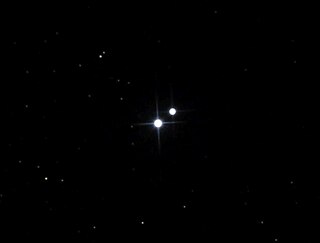 W
WThe Bayer designation ζ Lyrae is shared by two stars in the constellation Lyra:ζ1 Lyrae, an Am star ζ2 Lyrae, an F0 subgiant
 W
WZeta1 Lyrae, Latinized from ζ1 Lyrae, is a binary star in the northern constellation of Lyra. Based upon an annual parallax shift of 20.89 mas as seen from Earth, the pair are located about 156 light years from the Sun. It is visible to the naked eye with an apparent visual magnitude of 4.37.